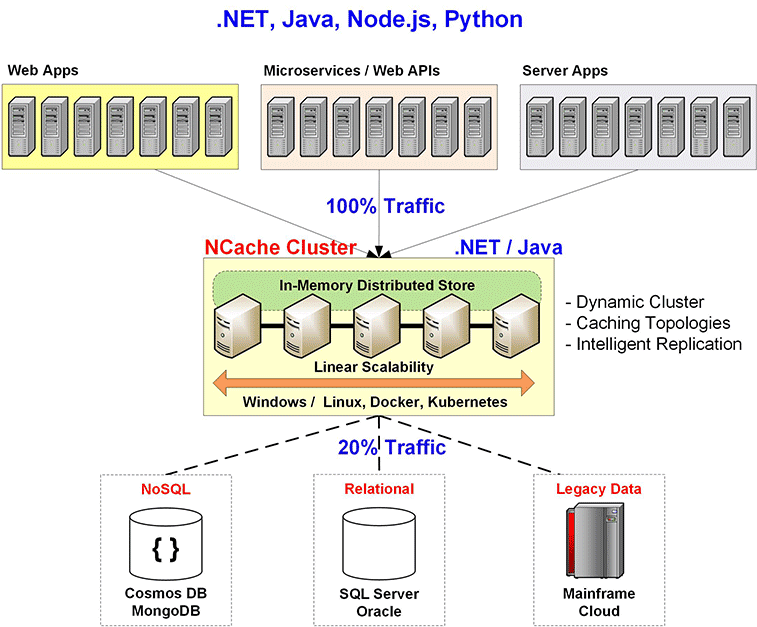In-Memory Distributed Cache
NCache is an extremely fast and scalable Open Source In-Memory Distributed Cache for .NET and Java that is ideal for high transaction server applications. NCache is extremely fast and linearly scalable and caches application data to reduce expensive database trips. Use NCache to remove performance bottlenecks and scale your applications to extreme transaction processing (XTP). NCache also provides dynamic clustering, intelligent data replication, and live persistence for high availability.
.NET Edition
- - Read-thru, Write-thru, Loader/Refresher
Other Clients: Java, Node.js, Python
Java Edition
- - Read-thru, Write-thru, Loader/Refresher
Other Clients: .NET, Node.js, Python
Common Uses of NCache
- App Data Caching (In-Memory with Live Persistence)
- .NET: NCache API, EF Core, NHibernate
- Java: NCache API, Hibernate, Spring, JCache
- Node.js/Python: NCache API
- Web App Caching
- ASP.NET Core: Sessions, Response Cache, SignalR, IDistributedCache
- ASP.NET: Session State, View State, Output Cache, SignalR
- Java/Node.js: Java Web Sessions, Node.js Web Sessions
- Messaging & Streams
- Pub/Sub Messaging, Continuous Query, Events
NCache Architecture

Featured Customers
Comparisons
Use Cases
Features & Capabilities
Use NCache as an extremely fast and linearly scalable distributed cache in the following environments and applications.
NCache Core Architecture
- Peer-to-peer dynamic cache cluster
- Caching Topology: Partitioned, Partition-Replica,
Mirrored, Replicated Cache - InProc speed with Client Cache (Near Cache)
- WAN replication with Bridge Topology
- Split Brain detection & recovery
Distributed Caching Features
- Expiration, Locking, Bulk & Async Ops
- Groups, Tags, Named Tags
- SQL and LINQ queries
- Read-through, Write-through, Write-behind
- Data Structures (List, Queue, Set, ...)
- Cache Loader & Refresher
Messaging, Events, Streams
- Pub/Sub Messaging with Topic (decoupled apps)
- Durable Subscriptions
- Continuous Query Events
- Item Level & Cache Level Events
Platforms
- Windows (.msi)
- Linux (.tar.gz, RPM, DEB)
- Kubernetes, Docker
- Azure AKS, AWS EKS, OpenShift, Google GKE
.NET Edition
- Server-side code (.NET): Read-thru, Write-thru, Loader, Refresher, Entry Processor
- Client (.NET): Directly talks to NCache servers. Provides all features.
- Other Clients: Java, Node.js, and Python
Java Edition
- Server-side code (Java): Read-thru, Write-thru, Loader, Refresher, Entry Processor
- Client (Java): Directly talks to NCache servers. Provides all features.
- Other Clients: .NET, Node.js, and Python












